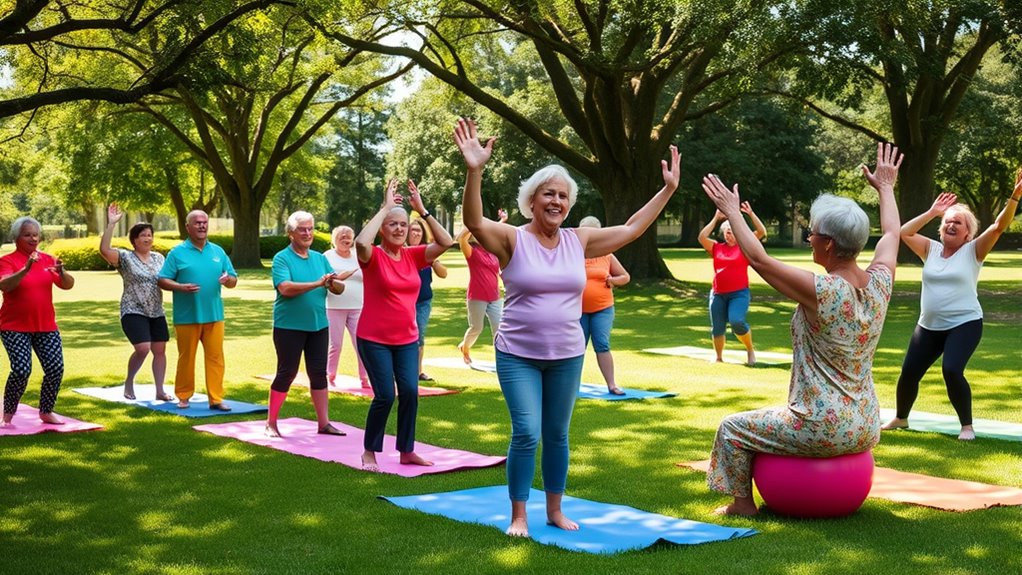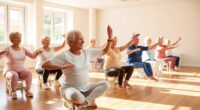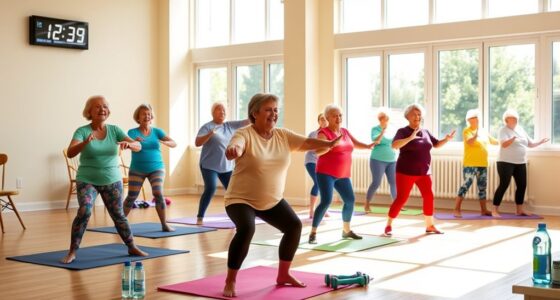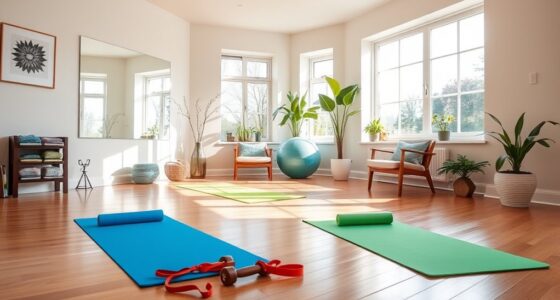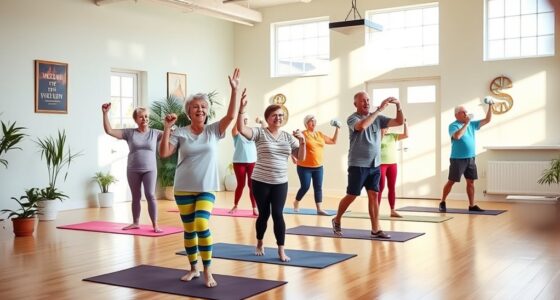You won’t believe how creative senior exercise programs can be! From the Go4Life campaign promoting strength and balance routines to using everyday items like water bottles for resistance training, the options are endless. Enjoy outdoor activities while staying hydrated and connect socially through group exercises. With fun routines that include yoga and tai chi for balance, there’s something for every fitness level. Discover even more exciting ideas that can enhance your wellness journey.
Key Takeaways
- Go4Life offers tailored exercise routines focusing on strength, balance, and flexibility specifically designed for seniors’ needs and abilities.
- Unique outdoor activities combine physical health benefits with enjoyment, enhancing engagement in exercise programs for seniors.
- Water bottle workouts and chair exercises creatively utilize everyday items for strength training, promoting independence and motivation among seniors.
- Balance practices like tai chi and yoga not only enhance physical stability but also contribute to emotional well-being by reducing anxiety and depression.
- Group exercise programs foster social connections, encouraging regular attendance and reducing feelings of loneliness in seniors.
The Go4Life Campaign: A Path to Wellness
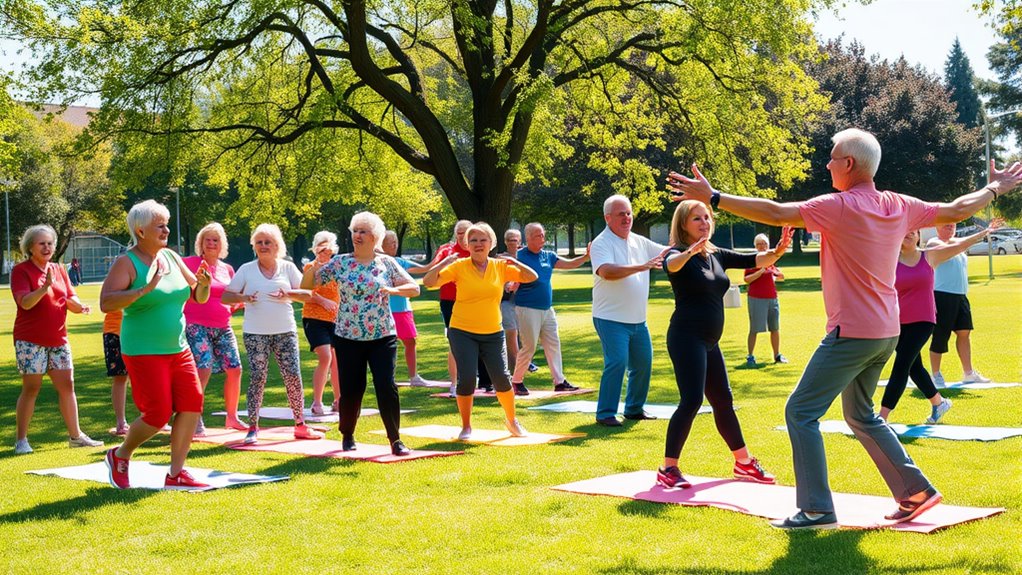
The Go4Life campaign is a fantastic resource. This program, initiated by the National Institute on Aging, offers tailored exercise routines that include strength, balance exercises, and flexibility training. Camping essentials can be integrated into your fitness journey to enhance your outdoor activities, promoting both physical health and enjoyment. Additionally, ensuring proper water sources while exercising outdoors can help maintain hydration and overall wellness. Creating a safe and accessible environment is crucial for seniors to fully engage in these exercise programs.
Incorporating exercises that improve balance and mobility is essential for preventing falls and enhancing overall stability. You’ll find it easy to lean forward into your fitness journey, using everyday items like chairs and weights. With a focus on good posture, you’ll learn to engage your muscles safely and effectively. The exercises are designed for all comfort levels, so you can modify them as needed.
Remember to stay hydrated and listen to your body. Incorporating regular physical activity into your routine can significantly improve overall health and well-being. Once you’re ready to go, you’ll feel more empowered and confident in your daily activities, paving the way to a healthier lifestyle.
Warm-Up Techniques for Seniors
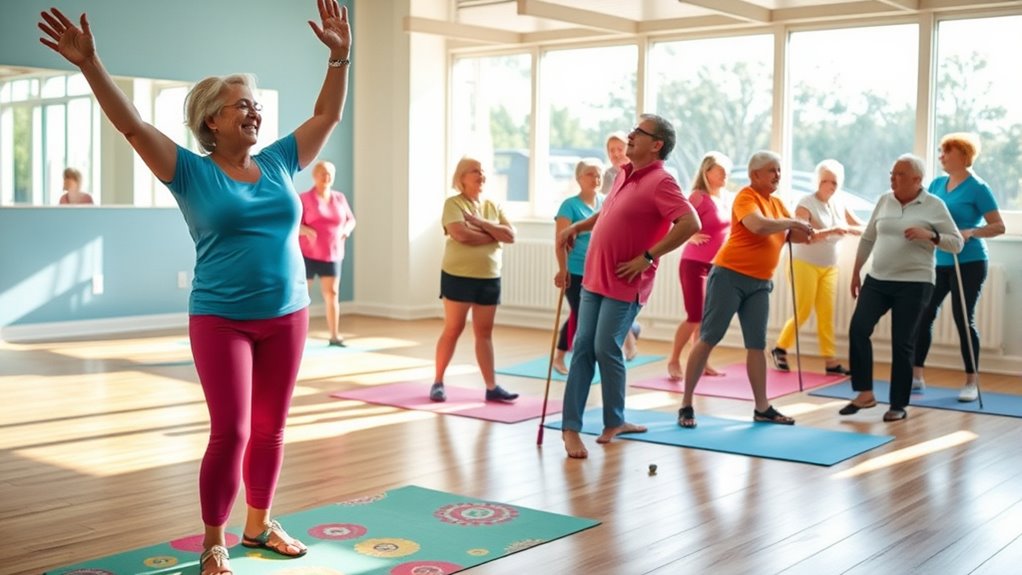
As you commence your fitness journey with programs like Go4Life, warming up becomes an important step to prepare your body for exercise. It elevates your heart rate, increases blood flow to your muscles, and reduces injury risk. Additionally, warming up can help improve muscle flexibility, which is crucial for preventing strains during your workout. To enhance your well-being, consider the benefits of air purification systems that can improve the air quality in your exercise environment. Regular home cleaning can also contribute to a more pleasant and motivating space for your workouts. Here are some effective warm-up techniques:
| Technique | Description |
|---|---|
| Marching in Place | Gradually raises your heart rate |
| Step Touches | Loosens shoulders while maintaining posture |
| Arm Circles | Dynamic stretch for shoulder mobility |
| Ankle Rolls | Enhances ankle flexibility |
| Seated Position | Comfortable option for leg prep |
Allocate at least 5 to 10 minutes for these exercises. Incorporating both standing and seated positions makes it easier for you to get moving while ensuring you’re ready for strength exercises ahead. Additionally, consider using essential oils for muscle relaxation to enhance your warm-up experience and promote overall comfort. Remember that fresh orange juice can be a refreshing post-exercise drink to help with hydration and recovery.
Strength Exercises Using Everyday Items
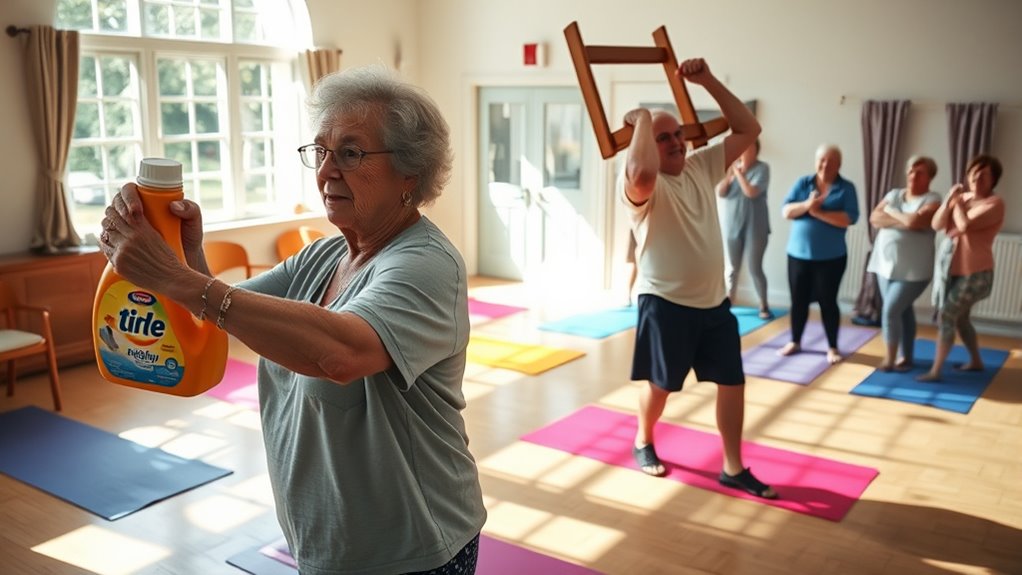
Incorporating strength exercises into your routine can be simple and effective, especially when you use everyday items found around your home. Grab two equally weighted water bottles to serve as makeshift dumbbells for arm curls or overhead raises. A sturdy chair can help you perform chair dips and stands, enhancing your upper body strength and core engagement. You can also use tennis balls during workouts to improve grip strength while making it more engaging. Additionally, implementing home security systems can provide peace of mind, allowing you to focus on your fitness routine without worry. Considering the cost of home security systems is essential, as it can vary based on the type of system and additional features you may want. A towel isn’t just for drying off; it can assist in resistance training and stretching post-workout. Incorporating wood pellet fireplaces into your home can also create a cozy atmosphere, making your workout space more inviting. With these strength exercises, you’ll not only build muscle but also improve your overall balance and coordination, essential for maintaining independence as you age. Engaging in regular physical activity, such as Montessori-inspired toys, can enhance your motivation to stay active. Additionally, aging in place can be supported by creating a safe and accessible environment that encourages regular physical activity.
Balance and Coordination Activities
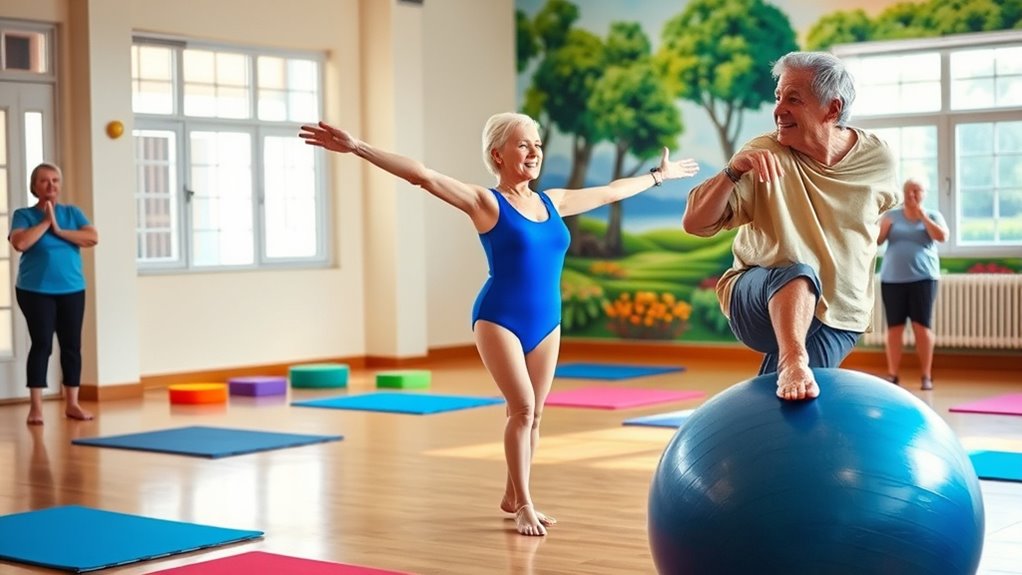
Balance and coordination activities are essential for maintaining stability and preventing falls as you age. Engaging in balance exercises like tai chi and yoga can greatly enhance your coordination skills, improving your overall stability by up to 30%. Additionally, incorporating portable camping toilets into outdoor activities can encourage more active lifestyles, allowing seniors to enjoy nature with ease. Including chia seeds in your diet can also support overall health, which is crucial for staying active as you age. Furthermore, recent trends in new Bitcoin holders controlling significant market supply indicate a growing interest in health and wellness investments among older adults. Regular exercise has been shown to reduce anxiety and depression symptoms, which is vital for emotional well-being.
Simple activities, such as standing on one leg or heel-to-toe walking, effectively strengthen your lower body and core muscles. To see noticeable improvements, aim to practice these exercises at least two to three times a week.
You can make workouts more enjoyable and challenging by incorporating props like stability balls or balance boards. This not only boosts your coordination skills but also promotes greater independence, allowing you to move with confidence in your daily life. Additionally, regular physical activity can help reduce anxiety and depression symptoms, contributing to overall emotional well-being.
Flexibility and Stretching Routines
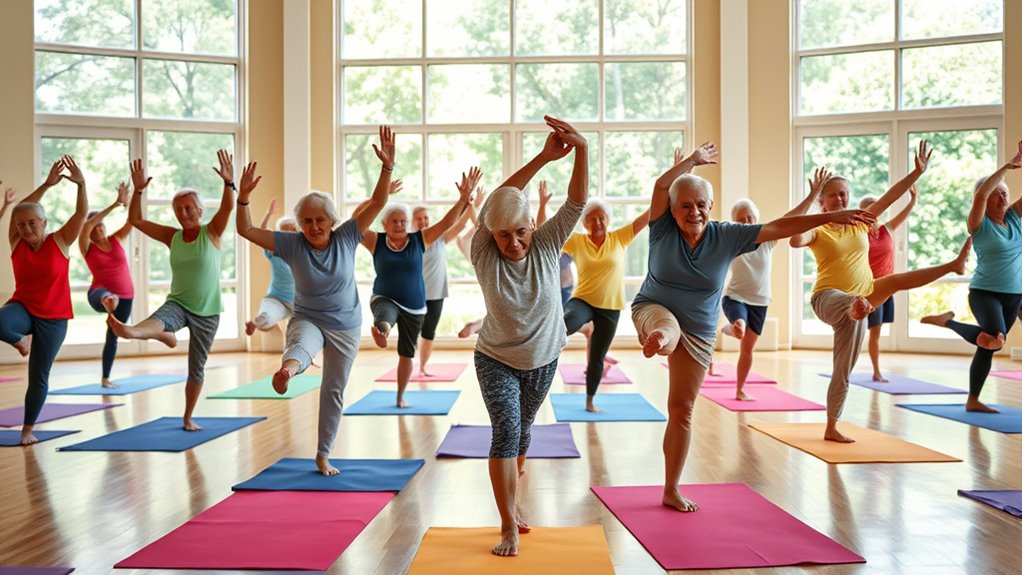
Flexibility and stretching routines play an essential role in helping seniors maintain their independence and mobility. Incorporating daily routines can notably improve your flexibility and range of motion. Start by warming up with activities like marching or step touches. As you stretch, hold each stretch for 15 to 30 seconds, using a towel for deeper shoulder and triceps stretches. Mix standing and seated positions to target all muscle groups. Don’t forget to focus on your breathing techniques, which can enhance relaxation and make your stretching more effective. Engaging in regular self-care practices can significantly contribute to overall well-being, as consistent exercise routines help improve not only physical health but also mental wellness. Additionally, implementing effective relaxation techniques can further support your flexibility efforts and promote a well-rounded approach to health. Somatic therapy techniques can also aid in enhancing body awareness and releasing tension during stretching exercises. Incorporating astrological compatibility into your self-care routine may enhance your confidence and motivation during exercise.
| Stretch Type | Duration | Breathing Technique |
|---|---|---|
| Shoulder Stretch | 15-30 seconds | Inhale deeply, exhale |
| Triceps Stretch | 15-30 seconds | Breathe slowly |
| Seated Hamstring | 15-30 seconds | Inhale, then exhale |
Engaging the Core: Simple Exercises
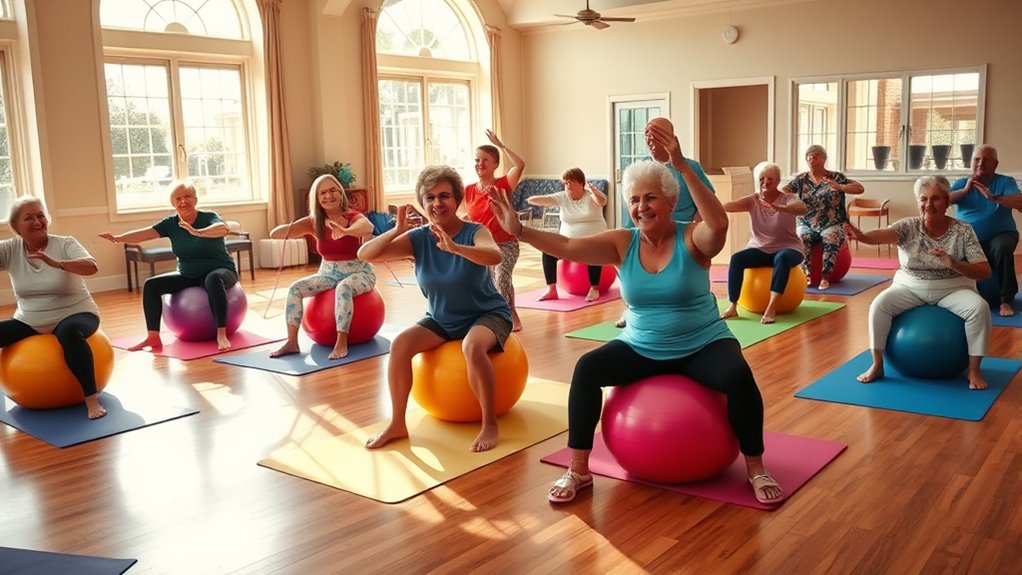
Engaging your core is essential for maintaining balance and stability, especially as you age. Simple exercises like seated leg lifts and standing torso twists can help strengthen your abdominal muscles while being easy to modify. Additionally, shared experiences can enhance motivation and commitment to regular exercise routines.
Core Strengthening Techniques
Core strength plays an essential role in enhancing your stability and mobility, especially as you age. Engaging in core strengthening exercises can help prevent falls and improve your overall function. Here are some simple techniques you can try:
| Exercise | Description |
|---|---|
| Seated Marches | While sitting, march in place to engage your core. |
| Back Leg Raises | Stand and hold onto a chair, lift one leg back, holding for 3-5 seconds. |
| Tennis Ball Squeeze | Hold a tennis ball in each hand, squeeze tightly to engage your abs. |
Remember to focus on good posture and breathing. You’re going to stretch and strengthen your core, which will lead to better balance. Keep it up, and you’re doing a good job!
Essential Stability Exercises
To maintain your balance and stability as you age, it’s important to incorporate essential stability exercises into your routine. Engaging the core is critical for reducing the risk of falls and enhancing mobility.
Simple exercises like seated leg lifts and standing side leg raises effectively target your core muscles, improving stability and posture. You can also try chair stands and back leg raises to strengthen your glutes and hamstrings, which are indispensable for maintaining balance.
Incorporating everyday objects, like tennis balls, can boost grip strength and core engagement, making workouts functional and enjoyable.
Consistent practice of these core stability exercises leads to improved range of motion and increased confidence in your daily activities.
The Importance of Hydration and Breaks
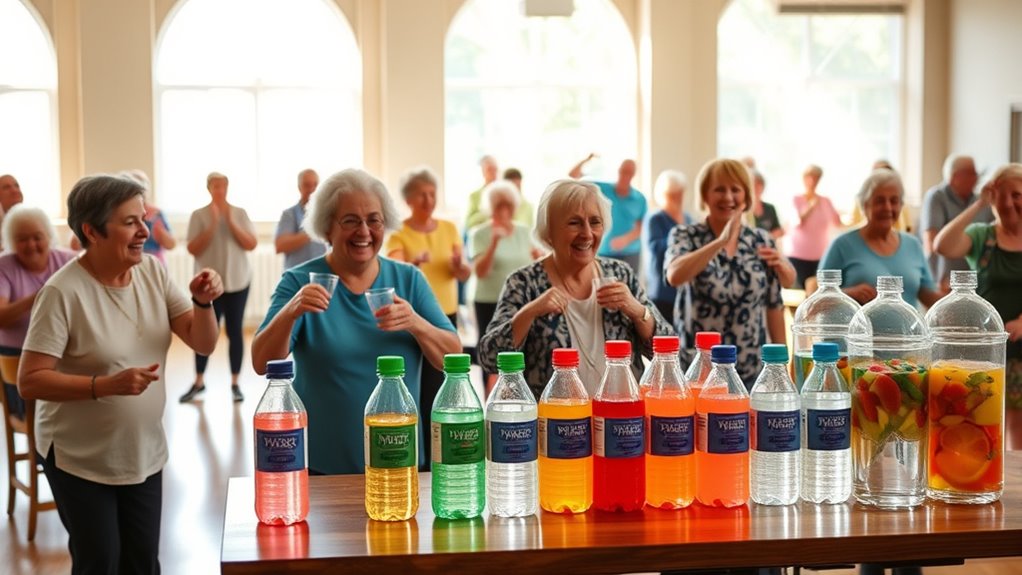
Staying hydrated is essential during your exercise routine, as it helps you maintain energy and prevents fatigue.
Remember to take regular breaks to rest and hydrate, which is especially important for your overall health.
Listening to your body won’t only enhance your performance but also keep you safe from potential injuries.
Hydration During Exercise
Hydration is essential during exercise, especially for seniors who can be more vulnerable to dehydration. Staying properly hydrated helps you maintain ideal performance and prevent fatigue.
The National Institute on Aging suggests drinking at least 8 ounces of water before you start exercising and sipping water every 15-20 minutes during your workout. Regular breaks not only give you a chance to hydrate but also allow you to listen to your body and adjust your intensity as needed.
Watch for signs of dehydration like dizziness, dry mouth, and fatigue. Recognizing these symptoms is vital for ensuring you stay healthy and active during your exercise routines.
Prioritizing hydration will help you enjoy your workouts more and feel your best.
Importance of Rest
Maintaining a proper hydration routine is just one part of a successful exercise program for seniors; equally important is recognizing the value of rest. Taking regular breaks during your workouts allows your body to recover, reduces injury risks, and helps you maintain proper form. Remember to listen to your body—rest whenever you feel fatigued or out of breath to avoid overexertion.
| Key Aspects | Benefits |
|---|---|
| Hydration | Maintains body temperature and prevents fatigue |
| Rest Periods | Aids muscle recovery and enhances workout enjoyment |
| Regular Breaks | Guarantees proper form and reduces injury risk |
| Listen to Your Body | Promotes sustainable exercise habits |
Social Benefits of Group Exercise Programs
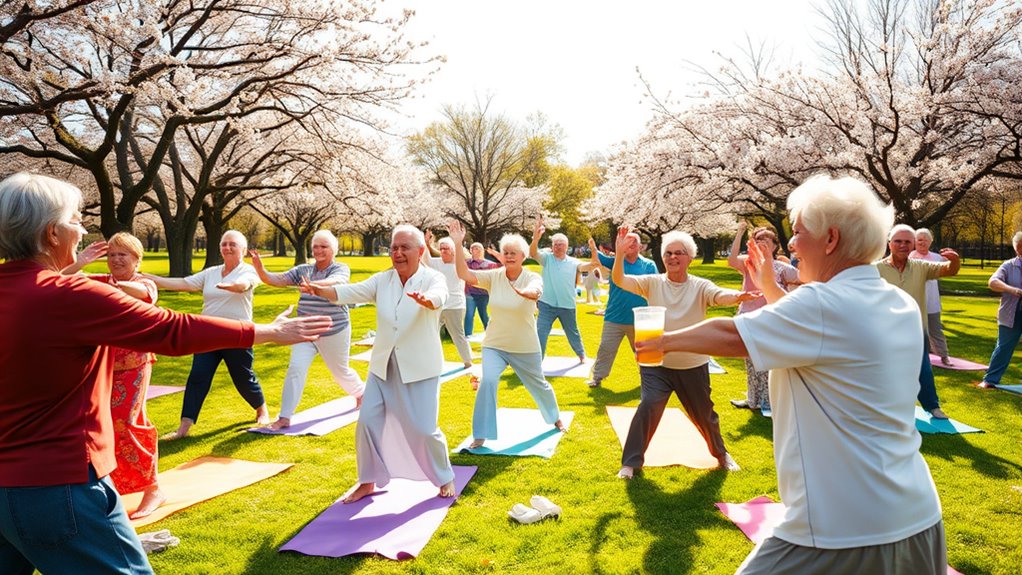
Group exercise programs offer seniors not just a chance to improve their physical fitness but also an invaluable opportunity for social engagement.
By participating in these classes, you can experience numerous social benefits that enhance your overall well-being:
- Socializing: Build friendships and reduce feelings of loneliness.
- Community: Foster a supportive network that encourages regular attendance.
- Emotional well-being: Lower rates of depression and anxiety through social connections.
- Motivation: Enjoy higher levels of enthusiasm, leading to better adherence to fitness routines.
- Cognitive skills: Stimulate conversation and teamwork, enhancing mental sharpness.
Engaging with others in a group setting not only makes exercise more enjoyable but also contributes positively to your mental health and social life.
Frequently Asked Questions
What Is the Number 1 Exercise to Increase Balance in Seniors?
The number one exercise to boost balance in seniors is the single-leg stand.
You stand on one leg for a set time, and it really enhances your stability and strengthens your lower body. Start by using a sturdy chair for support, then gradually try to rely less on it.
Practicing this for 10-15 seconds per leg multiple times a week can greatly reduce your risk of falls and improve your overall coordination.
What Is the #1 Exercise as You Get Older?
As you gracefully navigate the golden years, the #1 exercise you’ll want to embrace is strength training.
It’s not just about lifting weights; it’s about fortifying your body and spirit. By engaging in strength training at least twice a week, you’re enhancing your muscle mass and bone density, which keeps you steady and resilient.
Plus, it’s a fantastic way to boost your mental well-being, helping you feel more vibrant and connected.
What Exercise Burns the Most Belly Fat for Seniors?
To burn the most belly fat, you should combine aerobic exercises like brisk walking or swimming with strength training.
Adding high-intensity interval training (HIIT) into your routine can also be beneficial, with just 20-30 minute sessions making a difference.
Don’t forget about core strengthening exercises, like planks, which can help tone your abdominal muscles.
Maintain a balanced diet, and consider joining a group exercise program to keep you motivated and consistent.
What Is the Best Exercise Program for Seniors?
If you think exercise for seniors is all about gentle yoga and slow walks, think again!
The best exercise program for you incorporates strength, balance, and flexibility. You’ll want to include moves like arm curls and chair dips, using what you already have at home.
Remember to warm up, cool down, and listen to your body. Stay hydrated, take breaks, and keep it consistent to truly enhance your overall health and well-being.
Conclusion
In the vibrant tapestry of life, staying active weaves in threads of joy and connection. By exploring these unique senior exercise programs, you’re not just moving; you’re dancing through your golden years with strength, balance, and laughter. Embrace the warmth of community and the thrill of newfound energy. Every step you take is a brushstroke on the canvas of your health, painting a picture of resilience and joy that inspires not just you, but everyone around you.
